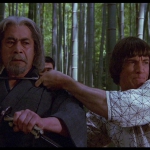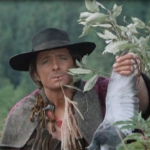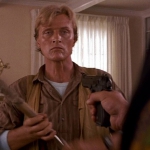SAMURAI GAIJIN | Offscreen
He wildly swings his katana, has pride to give, a drop of tea in the corner of his mouth, and never hides! Samurai and film have found each other more than a century ago, and his influence on Hollywood westerns and pop culture, in general, have turned him into a living archetype of film history. During the 2016 edition of Offscreen, a new touch was added: Rauni the Viking samurai appeared from the deepest Finnish dens, drunk from alcohol, love and an enlightened Japan. The encounter made us dizzy, wanting us to dig deep into cinematic history to incorporate the modest release of "Samurai Rauni" with unknown gems containing the same type of non-Japanese samurai – Gaijin, in other words. This quest has led us to many hours of exploitation cinema, expecting that the mere mention of "samurai", "kung fu" or "ninja" in the title would suffice to make fans go crazy... with a lot of semantic confusion as a result. There's a ninja (?) in "Black Samurai". And the first movie that places cowboys against Samourai, “De samurai en de ruiter” is also known as “Der Schrecken von Kung Fu” (The Fear of Kung Fu). But most of all, we get to know the funny and charismatic "Samurai Cop" – but be careful; he's a cop with a pulled katana fighting the "Fudge Fujiyama". Reasons enough to show this ultimate pulp movie on the big screen. Our quest also brought us to films that mix the katana with the colt to bare the similarities between both worlds. Finally, there are the movies that follow the concept truthfully: the man who learns the bushidô without being Japanese, the pure "samurai gaijin", following the example of the first non-Japanese samurai ever: Yasuke, a black slave who became a samurai in the 16th century. It'll become an unlikely five-week-long battlefield with five movies and a series of short films – colorful, funny, powerful, and controversial!
SAMOURAI RAUNI
For years, a quaint village in Finland has been bullied by the town drunk Samurai Rauni. Finally fed up with Rauni’s reign of terror, a mysterious person places a bounty on his head. A refreshing and wild blend of Japanese samurai cinema, sailor romance, Jodorowsky-style surrealism, and Finnish dipsomania.
THE CHALLENGE
Rick, a simple American boxer, has to hand an old katana, a heritage piece, to his rightful Japanese owner. He ends up in a battle for the sabre between two brothers. The first is a sensei of the traditional fence academy in the countryside; the other is a rich, criminal entrepreneur. He will be initiated in the way of the samurai and pick up the weapons. This is staggeringly realistic for a gaijin film. The legendary figure of the chanbara (Seven Samurai, The Legend of Musashi, The Sword of Doom...), Toshirô Mifune, takes him under his care, as an old but efficient sensei. "The Challenge" never lowers itself to ridiculous clichés, but ties into medieval Japanese combat art. The American hero may be the only authentic gaijin samurai of this programme – together with Rauni, of course.
SAMOURAI RAUNI
For years, a quaint village in Finland has been bullied by the town drunk Samurai Rauni. Finally fed up with Rauni’s reign of terror, a mysterious person places a bounty on his head. A refreshing and wild blend of Japanese samurai cinema, sailor romance, Jodorowsky-style surrealism, and Finnish dipsomania.
SAMOURAI RAUNI
For years, a quaint village in Finland has been bullied by the town drunk Samurai Rauni. Finally fed up with Rauni’s reign of terror, a mysterious person places a bounty on his head. A refreshing and wild blend of Japanese samurai cinema, sailor romance, Jodorowsky-style surrealism, and Finnish dipsomania.
THE SILENT STRANGER
With the saddle on the shoulder and a hanged horse, an anonymous cowboy awakens in the middle of a crowd of intrigued and mocking farmers. After a journey of several months, he winds up in a Japanese harbour to claim the several thousands of dollars promised to him on a parchment that he now has to hand over to a certain Motori. The case is promising but unpredictable, especially when a well informed samurai steals his freedom and his horse. Directed in 1968 by Luigi Vanzi and produced by the main actor Tony Anthony, "Lo straniero di silenzio" is a film from the late 1960s that is historically the first that combined two brotherly genres, samurai and western. And he does it with a lot of empathy: from the very first minute, we see that the cowboy doesn't understand a thing and fails entirely. No translator or common ground in this land wiped away by typhoons. For a few dollars more, the foreigner plays the part of the grain of sand that goes from one clan to the other in the ultimate fight between two clans of samurai. Halfway between western and chanbara, we get to meet a multilingual princess, a sword dwarf, a gun in medieval Japan, and an undescribable vehicle. A fun rarity!
SAMOURAI RAUNI
For years, a quaint village in Finland has been bullied by the town drunk Samurai Rauni. Finally fed up with Rauni’s reign of terror, a mysterious person places a bounty on his head. A refreshing and wild blend of Japanese samurai cinema, sailor romance, Jodorowsky-style surrealism, and Finnish dipsomania.
SAMURAI COP
With a corpus of work that is miles away from Avi Mograbi, Amir Shervan ("Hollywood Cop", "Killing American Style") is not your typical Middle Eastern filmmaker. After a handful of B-movie gems, Amir helms "Samurai Cop" in 1991, his fifth and last feature film. It's a sleeper in the kingdom of so-bad-it's-good movies that has recently gained cult status, more than 20 years after its video release. "Samurai Cop" is more a buddy-cop than a samurai movie and tries to cash in on the fading rage of cinematic combat sports with its title. With the unknown duo Matt Hannon and Mark Frazer, and more recognizable faces from low-budget cinema like Robert Z’Dar and Gerald Okamura, this film is the perfect example of shameless exploitation, seemingly made from fragments, non-rehearsed scenes, and ramshackle dialogue. Ultimate pulp!
SAMOURAI RAUNI
For years, a quaint village in Finland has been bullied by the town drunk Samurai Rauni. Finally fed up with Rauni’s reign of terror, a mysterious person places a bounty on his head. A refreshing and wild blend of Japanese samurai cinema, sailor romance, Jodorowsky-style surrealism, and Finnish dipsomania.
BLIND FURY
The west takes over one of the great myths of the chanbara in 26 episodes, readapted in 2003 by Takeshi Kitano, the one from “Zatoichi: The Blind Swordsman”. From the start, “Blind Fury” restrains from each Nipponism by turning his hero into a blind Vietnam veteran, initiated by several locals in the art of sword fighting. Back in the US and armed with his disguised crutch, he defends the weak with modesty but efficiency. The humor that was already present in the original Zatoichi series gets a modern twist (i.e. he drives a car in a crowded city center), and Blind Fury” stays nicely down to earth. Rutger Hauer, Paul Verhoeven's fetish actor, is believable and delivers, according to himself, his most powerful performance. For the occasion, he worked together with blind actor and judo champion Lynn Manning, who gave him the advice, “I don't let myself get blindsided”.











